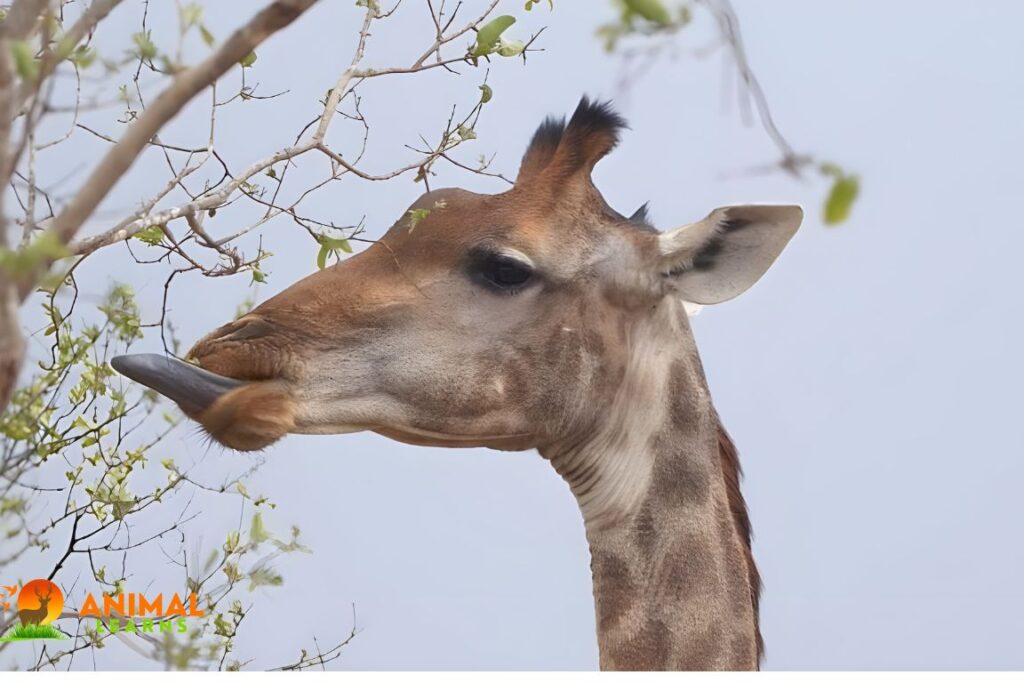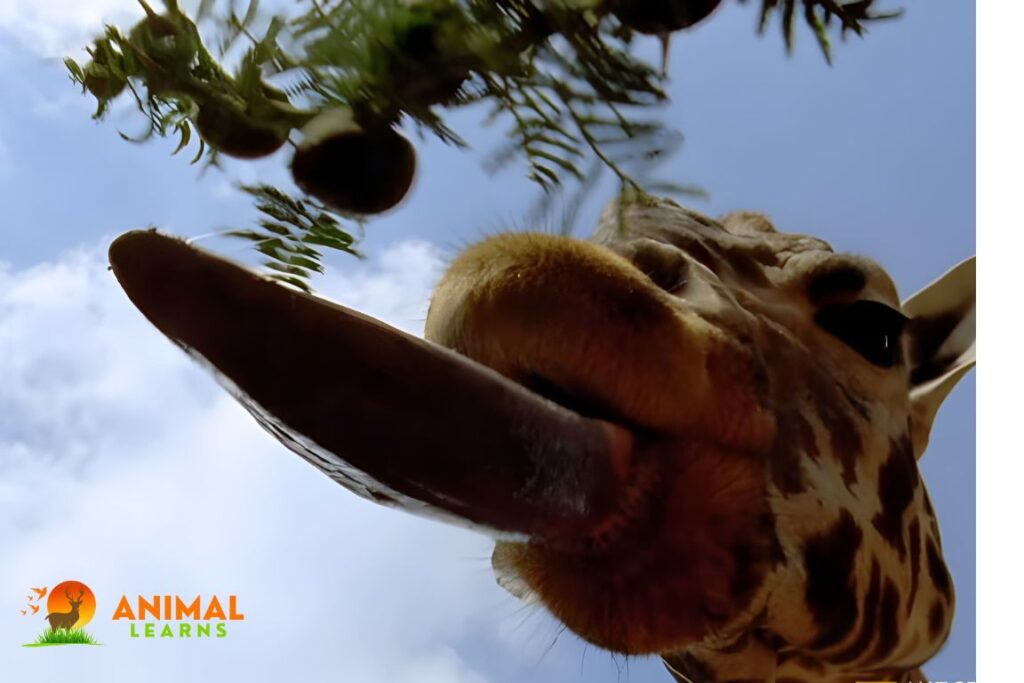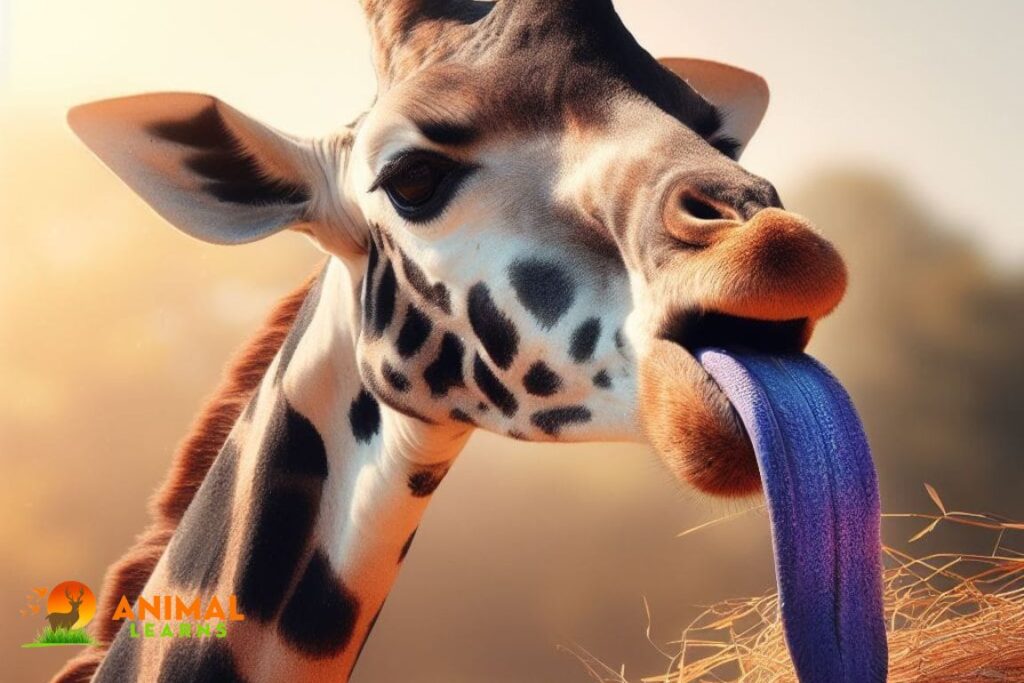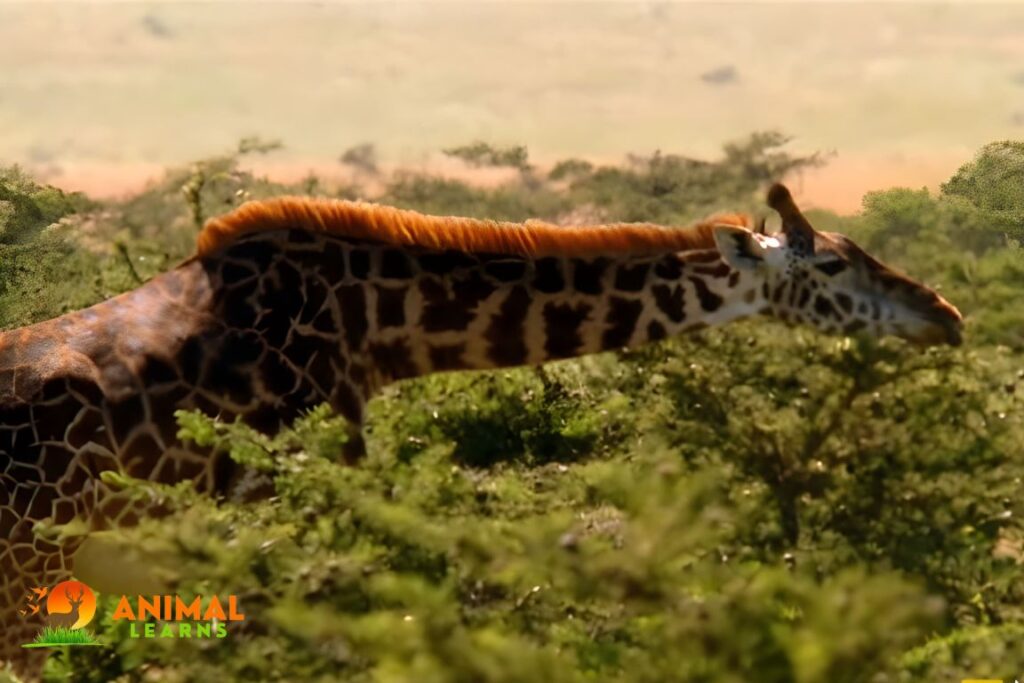The Surprising Secret of Giraffe Tongue Color!

| Aspect | Information |
| Color | Typically blue to nearly black |
| Texture | Rough and covered in papillae |
| Length | Up to 18-20 inches (45-50 cm) |
| Function | Used for grasping leaves from trees, grooming, and social interactions |
| Adaptation | Helps protect against sunburn and manipulate leaves in trees |
| Uniqueness | One of the darkest tongues among herbivores |
| Communication | Used in social interactions and expressions |
Giraffe tongue color serves as a grabbing entry point into a galaxy of amazing adaptations in the interesting world of giraffes. Welcome to our examination of Giraffe Tongue Color, in which we will discover the mysteries of the colors, textures, and functions of this essential organ.
This article takes you on a journey through the brilliant and unique palette that is a giraffe’s tongue, from colors of blue, black, and even purple, to the remarkable ways that their jaws help them live in the wild.
Understanding Giraffe Tongue Color
Contents

What Is the Color of the Giraffe Tongue?
A giraffe’s tongue is a fascinating shade of blue, which often surprises people who expect a more conventional color. This unique feature serves as a distinctive adaptation in their evolutionary journey.
Understanding the giraffe tongue color, as well as what color the giraffe tongue can be, is not only a captivating aspect of their biology but also plays a crucial role in their conservation. The blue hue is attributed to the high concentration of melanin, the same pigment responsible for skin and hair color in animals.
Understanding this unusual coloration is essential for appreciating the intricate adaptations and functions of a giraffe’s tongue, which go far beyond its visual appeal.
Variation in Tongue Color
Melanin makes skin, hair, and eyes dark in animals and people. It also makes giraffe tongues dark. But not all tongues are the same black or purple color. Some are lighter or darker because of genes, age, or weather. For example, old giraffes may have darker tongues than young ones.
Purpose of the Tongue’s Coloration
The dark color of giraffe tongues is not just for show. It serves several important purposes that help giraffes survive and thrive in their habitat. Here are some of them:
Sun Protection: Giraffes live in regions where the sun is very strong and harsh. They also feed on acacia trees, which have long and sharp thorns that can injure their mouths. The dark tongue color acts as a natural sunscreen, shielding their tongues from sunburn and cuts as they reach for food in high branches.
Thermoregulation: The dark tongue color may also help giraffes regulate their body temperature. Dark colors absorb more heat than light colors, so by sticking out their tongues, giraffes may be able to cool down faster by releasing heat through their tongues.
Camouflage: While the main function of the dark tongue color is not to hide from predators, it does help giraffes blend in with their surroundings. When giraffes feed among the shadows and leaves of trees, their tongues do not stand out much, making them less noticeable to lions and other enemies.
Tongue Length and Size
The giraffe’s tongue length and size are nothing short of remarkable. Stretching up to 45 centimeters (approximately 18 inches), their tongues are not only among the longest in the animal kingdom but also an essential adaptation for their unique lifestyle.
This extraordinary length allows giraffes to reach foliage high in the trees that other herbivores cannot access. Moreover, their prehensile tongues are adept at grasping and pulling leaves off branches, making them exceptionally efficient herbivores.
The ability to exploit these hard-to-reach food sources and their specialized tongues play a pivotal role in the giraffe’s survival, making them truly captivating creatures to study.
Why Some Giraffes Have Black or Purple/Dark Color Tongues

Debunking common myths about giraffe tongue color is vital. Many believe in striking shades of blue, black, or purple tongues, rooted in folklore. In reality, a giraffe’s tongue is typically a dark shade of blue, appearing nearly black due to unique pigmentation and the African sun.
Understanding this biology is crucial for appreciating nature’s complexities and dispelling long-held myths. Top of FormThe prevalence of black or purple tongues in giraffes is primarily due to their melanin content.
Melanin is responsible for the coloration of various body parts in animals. In the case of giraffes, the tongue’s melanin-rich tissues are dark-colored to provide the mentioned benefits of sun protection and heat dissipation.
Therefore, it’s not a matter of “some” giraffes having black or purple tongues; rather, it’s a characteristic feature of the species as a whole. The specific shade may vary slightly, but the underlying purpose remains consistent: to help these remarkable animals thrive in their unique and challenging environments.
The Fascinating World of Giraffe Tongue Color
Discussing the Variety of Keywords Related to Giraffe Tongue Color
Giraffe tongue color is a topic that piques curiosity and leads to a myriad of related keywords. In discussions about this subject, you’ll come across phrases like “What color are giraffes’ tongues,” “What is a giraffe’s tongue color,” and “Why is giraffe tongue black.”
These keywords not only reflect people’s curiosity about giraffe tongue color but also reveal the existence of common misconceptions regarding the subject. The variety of keywords highlights the need for comprehensive information and clarification on the actual color and significance of giraffe tongues.
The Significance of Understanding Giraffe Tongue Color
Understanding the color of a giraffe’s tongue is not just a quirky fact; it has profound significance in appreciating the complexity of these magnificent creatures. The tongue’s blue coloration has evolved to protect it from the harsh African sun while it feeds on thorny acacia leaves.
Moreover, the texture and color of the tongue play a pivotal role in various aspects of a giraffe’s life, including feeding, communication, and grooming. Thus, grasping the significance of giraffe tongue color unveils the rich tapestry of adaptations that enable them to thrive in their natural habitat.
What Colors Do Giraffes’ Tongues Come In?

Giraffe tongues are not often discussed, but they are quite fascinating. Unlike many other animals, giraffe tongues are not just one solid color. In fact, they come in various hues and shades, which can range from pink and purple to black and blue.
Among the different colors, the most common ones observed for giraffe tongues are blue, black, and purple. This unique variety of shades is due to the high concentration of a pigment called melanin, which is responsible for the dark coloration in many animals.
The amount of melanin in the giraffe’s tongue determines its specific shade, resulting in our delightful palette. However, it is essential to address some misconceptions surrounding giraffe tongue color. Many people believe that giraffe tongues are blue or black because they are adapted to protect against sunburns or insects.
While this theory is quite interesting, it is not entirely accurate. The actual reason for their unique coloration is still not fully understood by scientists, but it is fascinating to note that it has nothing to do with sun protection or insect repellency.
Conservation and the Future of Giraffes

Understanding giraffe biology has far-reaching implications, especially concerning conservation efforts. These gentle giants, whose populations have been dwindling, hold a crucial place in the ecosystem. Recognizing their intricate biology, including their distinctive tongue colors, is essential for preserving giraffe populations.
Understanding the giraffe tongue coolor, whether they’re blue, black, or another shade, can serve as an indicator of the overall health of these magnificent creatures. By monitoring and protecting the well-being of giraffes, we not only safeguard their future but also contribute to the broader conservation of biodiversity and the delicate balance of our planet’s ecosystems.
Conclusion
Giraffes, with their extraordinary adaptations, have always mesmerized scientists and wildlife enthusiasts alike. One particular aspect that showcases their uniqueness is the color of their tongues. Giraffes possess dark, purple tongues to protect against sunburn as they spend long hours reaching for leaves in the African savannah.
Additionally, their tongues are incredibly tough and flexible, allowing them to expertly navigate around sharp thorns on trees. This fascinating trait not only emphasizes the incredible adaptability of giraffes but also prompts further exploration into their other intriguing features.
By delving deeper into the world of giraffes, researchers can unlock more secrets behind their survival in the wild – a captivating endeavor indeed.
FAQs
What is the color of a giraffe’s tongue?
A giraffe’s tongue is typically black or dark blue in color.
Why is a giraffe’s tongue so dark?
The dark color of a giraffe’s tongue is thought to protect it from sunburn and provide a natural camouflage against predators.
Do all giraffes have the same colored tongues?
Yes, the color of a giraffe’s tongue is consistent across all species of giraffes.
How long is a giraffe’s tongue?
On average, a giraffe’s tongue can grow 18-20 inches long.
What is the purpose of a giraffe’s long tongue?
A giraffe’s long tongue is an adaptation that helps them reach food in high trees and pull leaves from branches.













